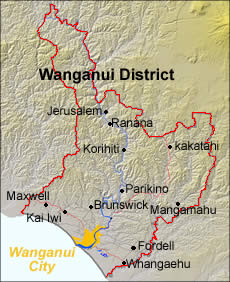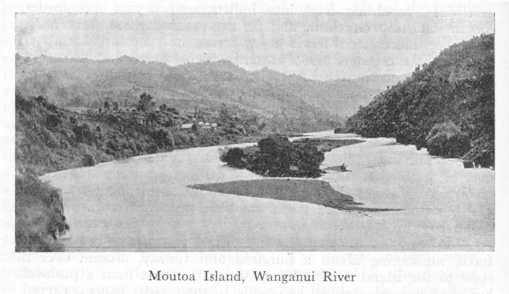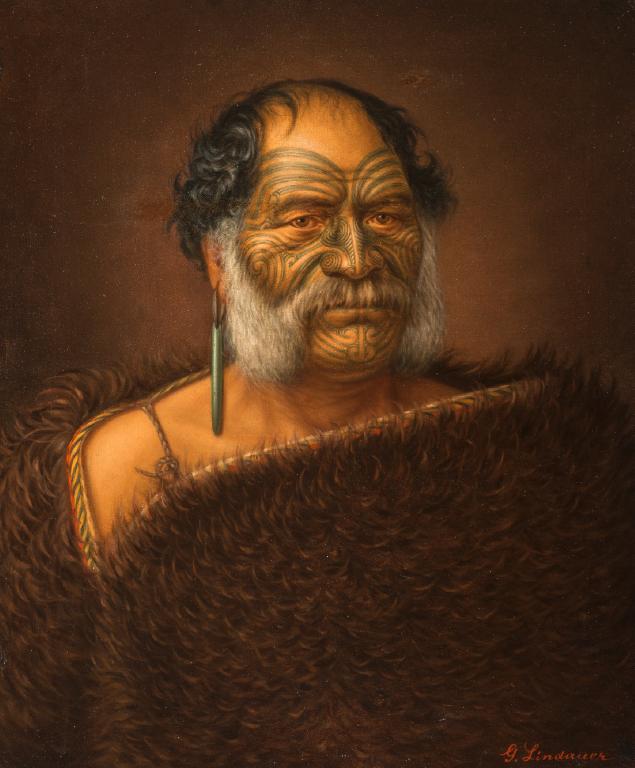|
Pūtiki
Putiki is a settlement in the Whanganui District and Manawatū-Whanganui region of New Zealand's North Island, located across the Whanganui River from Whanganui city. It includes the intersection of New Zealand State Highway 3, State Highway 3 and New Zealand State Highway 4, State Highway 4. The settlement was established around Pūtiki Pā, a tribal meeting ground of Ngāti Tumango and Ngāti Tupoho. It features Te Paku o Te Rangi meeting house, also known as Aotea meeting house. History 19th century Pūtiki Pā, recorded variously as Putiki Wharanui, Putiki Wharenui, Putiki Warenui, or by its full name Putiki-wharanui-a-Tamatea-pokai-whenua, as a well established pā well before European arrival. The settlement was attacked by Ngāti Toa in a bloody two-month siege in 1828 or 1829. About 400 locals were killed in the encounter. Pūtiki was the main Māori settlement at the Whanganui River mouth when Europeans began settling on the river in the 1840s. Māori from Pūtiki ... [...More Info...] [...Related Items...] OR: [Wikipedia] [Google] [Baidu] |
Whanganui
Whanganui, also spelt Wanganui, is a city in the Manawatū-Whanganui region of New Zealand. The city is located on the west coast of the North Island at the mouth of the Whanganui River, New Zealand's longest navigable waterway. Whanganui is the 19th most-populous urban area in New Zealand and the second-most-populous in Manawatū-Whanganui, with a population of as of . Whanganui is the ancestral home of Te Āti Haunui-a-Pāpārangi and other Whanganui Māori tribes. The New Zealand Company began to settle the area in 1840, establishing its second settlement after Wellington. In the early years, most European settlers came via Wellington. Whanganui greatly expanded in the 1870s, and freezing works, woollen mills, phosphate works and wool stores were established in the town. Today, much of Whanganui's economy relates directly to the fertile and prosperous farming hinterland. Like several New Zealand urban areas, it was officially designated a city until an administrative r ... [...More Info...] [...Related Items...] OR: [Wikipedia] [Google] [Baidu] |
Hoani Wiremu Hīpango
Hoani Wiremu Hīpango ( 1820 – 25 February 1865) was a Māori tribal leader, teacher and assessor of the Whanganui River area of New Zealand. He was a leader of Ngāti Tumango, of the Te Āti Haunui-a-Pāpārangi iwi. He converted to Christianity and was baptised at Putiki, near present-day Whanganui, in 1841. He visited England with missionary Richard Taylor in 1855. He opposed the Pai Mārire (Hauhau) movement in the 1860s and led anti-Hauhau forces in battle. In February 1865, he led an attack on a Hauhau pā near Pipiriki. They captured the pā The word pā (; often spelled pa in English) can refer to any Māori people, Māori village or defensive settlement, but often refers to hillforts – fortified settlements with palisades and defensive :wikt:terrace, terraces – and also to fo ..., but Hīpango was seriously injured and died of his wounds two days later, on 25 February, at the age of about 45. He was buried at Korokata hill, overlooking Pūtiki. References ... [...More Info...] [...Related Items...] OR: [Wikipedia] [Google] [Baidu] |
Whanganui District Council
The Whanganui District Council, formerly spelled Wanganui District Council, is the territorial authority for Whanganui District, New Zealand, comprising the city of Whanganui and its surrounding areas. The council is made up of a mayor and 12 councillors, all elected at-large. They are elected using a first-past-the-post system in triennial elections, with the most recent elections having been held in 2022. The current mayor is . History Local government in Whanganui began with the creation of the Wanganui Town Board, within Wellington Province, in 1862. Following the abolishment of the Wellington Province, Wanganui County was founded in 1876. The town board was elevated to a borough council in 1872, and then to a city council in 1924 following amalgamation with the town boards of Wanganui East, Gonville and Castlecliff. Wanganui District Council formed after the 1989 local government reforms with the amalgamation of the Wanganui City Council with the Wanganui C ... [...More Info...] [...Related Items...] OR: [Wikipedia] [Google] [Baidu] |
Ngāti Toa
Ngāti Toa, also called Ngāti Toarangatira or Ngāti Toa Rangatira, is a Māori people, Māori ''iwi'' (tribe) based in the southern North Island and the northern South Island of New Zealand. Ngāti Toa remains a small iwi with a population of about 9,000. The iwi is centred around Porirua, Plimmerton, Kāpiti Coast District, Kāpiti, Blenheim, New Zealand, Blenheim and Arapaoa Island, Arapaoa Island. It has four marae: Takapūwāhia and Hongoeka in Porirua City, and Whakatū Marae, Whakatū and Wairau Marae, Wairau in the South Island. Ngāti Toa's governing body has the name ''Te Rūnanga o Toa Rangatira''. The iwi traces its descent from the eponymous ancestor Toarangatira. Ngāti Toa lived in the Kawhia Harbour, Kāwhia region of the North Island until the 1820s, when forced out by conflict with other Tainui iwi, led by Pōtatau Te Wherowhero ( – 1860), who later became the first Māori King Movement, Māori King (). Ngāti Toa, Ngāti Rārua and Ngāti Koata, led by Te Ra ... [...More Info...] [...Related Items...] OR: [Wikipedia] [Google] [Baidu] |
Ngāti Poutama
Iwi () are the largest social units in New Zealand Māori society. In Māori, roughly means or , and is often translated as "tribe". The word is both singular and plural in the Māori language, and is typically pluralised as such in English. groups trace their ancestry to the original Polynesian migrants who, according to tradition, arrived from Hawaiki. Some cluster into larger groupings that are based on (genealogical tradition) and known as (literally , with reference to the original migration voyages). These super-groupings are generally symbolic rather than logistical. In pre-European times, most Māori were allied to relatively small groups in the form of () and (). Each contains a number of ; among the of the Ngāti Whātua iwi, for example, are Te Uri-o-Hau, Te Roroa, Te Taoū, and Ngāti Whātua-o-Ōrākei. Māori use the word ''rohe'' for the territory or boundaries of iwi. In modern-day New Zealand, can exercise significant political power in the manage ... [...More Info...] [...Related Items...] OR: [Wikipedia] [Google] [Baidu] |
Mete Kīngi Paetahi
Mete Kīngi Te Rangi Paetahi (c. 1813 – 22 September 1883) was a Member of Parliament in New Zealand. He was one of four Māori elected in the first Māori elections of 1868 for the new Māori electorates in the House of Representatives. Private life Mete Kīngi was the chief of the Ngāti Poutama (or Ngā Poutama) and Ngāti Tūmango hapu of Te Āti Haunui-a-Pāpārangi in the Whanganui River area. His father was Paetahi and his mother Utaora. He opposed the Pai Mārire (Hauhau) movement in the 1860s and fought against the Hauhau, becoming known popularly as 'General Mete Kīngi'. When Hōri Kīngi Te Ānaua died in September 1868, Mete Kīngi succeeded him as the highest-ranking chief in the tribes of the lower Wanganui. Political career Mete Kīngi was the only candidate proposed at the nomination meeting for Western Maori, one of the new Māori electorates, at the Wanganui Courthouse in 1868, and was thus elected unopposed. As he had a salaried position as Assess ... [...More Info...] [...Related Items...] OR: [Wikipedia] [Google] [Baidu] |
George Grey
Sir George Grey, KCB (14 April 1812 – 19 September 1898) was a British soldier, explorer, colonial administrator and writer. He served in a succession of governing positions: Governor of South Australia, twice Governor of New Zealand, Governor of Cape Colony, and the 11th premier of New Zealand. He played a key role in the colonisation of New Zealand, and both the purchase and annexation of Māori land. Grey was born in Lisbon, Portugal, just a few days after his father, Lieutenant-Colonel George Grey, was killed at the Battle of Badajoz in Spain. He was educated in England. After military service (1829–37) and two explorations in Western Australia (1837–39), Grey became Governor of South Australia in 1841. He oversaw the colony during a difficult formative period. Despite being less hands-on than his predecessor George Gawler, his fiscally responsible measures ensured the colony was in good shape by the time he departed for New Zealand in 1845.G. H. Pitt, "The Cr ... [...More Info...] [...Related Items...] OR: [Wikipedia] [Google] [Baidu] |
Moutoa Island
Moutoa Island is an island of shingle approximately long, up the Whanganui River, New Zealand between the towns of Rānana and Hiruharama. Surrounded by rapids, it has been the site of many battles, the most famous being on 14 May 1864, between a force of Pai Mārire followers from the upper Whanganui and Ngāti Hau from the lower Whanganui, during the Second Taranaki War. A statue unveiled in 1865 in Moutoa Gardens in Whanganui Whanganui, also spelt Wanganui, is a city in the Manawatū-Whanganui region of New Zealand. The city is located on the west coast of the North Island at the mouth of the Whanganui River, New Zealand's longest navigable waterway. Whanganui is ... commemorates the battle. References External links * Whanganui River Landforms of Manawatū-Whanganui River islands of New Zealand {{ManawatuWanganui-geo-stub ... [...More Info...] [...Related Items...] OR: [Wikipedia] [Google] [Baidu] |
Pai Mārire
The Pai Mārire movement (commonly known as Hauhau) was a syncretic Māori religion founded in Taranaki by the prophet Te Ua Haumēne. It flourished in the North Island from about 1863 to 1874. Pai Mārire incorporated biblical and Māori spiritual elements, and promised its followers deliverance from European domination. Although founded with peaceful motives—its name means "Good and Peaceful"—some followers of Pai Mārire became known for an extremist form of the religion. These extremists were labelled as "Hauhau" by the Europeans.Paul Clark, "Hauhau: The Pai Marire Search for Maori Identity," (1975) as cited by Belich in "The New Zealand Wars" (1986), chapter 11. The rise and spread of the violent expression of Pai Mārire was largely a response to the New Zealand Government's military operations against the North Island Māori, which were aimed at exerting European sovereignty and gaining more land for white settlement; historian B.J. Dalton claims that after 1865 any ... [...More Info...] [...Related Items...] OR: [Wikipedia] [Google] [Baidu] |
Richard Taylor (missionary)
Richard Taylor (21 March 1805 – 10 October 1873) was a Church Missionary Society (CMS) missionary in New Zealand. He was born on 21 March 1805 at Letwell, Yorkshire, England, one of four children of Richard Taylor and his wife, Catherine Spencer. He attended Queens' College, Cambridge and after graduating BA in 1828, he was ordained as a priest on 8 November 1829. In 1835, he was conferred MA and appointed a missionary in New Zealand for the CMS. Church Missionary Society Taylor was present at the signing of the Treaty of Waitangi on 6 February 1840. In 1840, he was appointed as head of the school at Te Waimate mission, then in 1842 posted to the CMS mission station at Whanganui. By 1844, the brick church built by the Revd John Mason was inadequate to meet the needs of the congregation and it had been damaged in an earthquake. A new church was built under the supervision of the Revd Richard Taylor with the timber supplied by each pā on the river in proportion to it ... [...More Info...] [...Related Items...] OR: [Wikipedia] [Google] [Baidu] |
Hōri Kīngi Te Ānaua
Hōri Kīngi Te Ānaua (died 18 September 1868) was a leader of Ngāti Ruaka, a subtribe of Te Āti Haunui-a-Pāpārangi ''iwi'' ( Māori tribe) of New Zealand in the early and mid 19th century. He was a leader of the tribes of the Wanganui River The Wanganui River is in the West Coast, New Zealand, West Coast of the South Island of New Zealand. It flows northwest for from its headwaters in the Southern Alps, entering the Tasman Sea near Lake Ianthe, southwest of Hokitika. After hea ... district in the tribal wars of the early 19th century. Rere-ō-maki, mother of military leader Te Keepa Te Rangihiwinui (Major Kemp), was his sister. References 1868 deaths Te Āti Haunui-a-Pāpārangi people Signatories of the Treaty of Waitangi Year of birth missing {{Māori-bio-stub ... [...More Info...] [...Related Items...] OR: [Wikipedia] [Google] [Baidu] |
Christianity
Christianity is an Abrahamic monotheistic religion, which states that Jesus in Christianity, Jesus is the Son of God (Christianity), Son of God and Resurrection of Jesus, rose from the dead after his Crucifixion of Jesus, crucifixion, whose coming as the Messiah#Christianity, messiah (Christ (title), Christ) was Old Testament messianic prophecies quoted in the New Testament, prophesied in the Old Testament and chronicled in the New Testament. It is the Major religious groups, world's largest and most widespread religion with over 2.3 billion followers, comprising around 28.8% of the world population. Its adherents, known as Christians, are estimated to make up a majority of the population in Christianity by country, 157 countries and territories. Christianity remains Christian culture, culturally diverse in its Western Christianity, Western and Eastern Christianity, Eastern branches, and doctrinally diverse concerning Justification (theology), justification and the natur ... [...More Info...] [...Related Items...] OR: [Wikipedia] [Google] [Baidu] |





